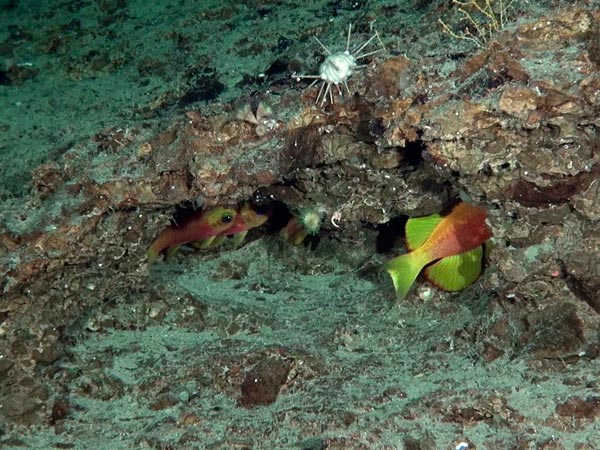Name This Fish Contest: Winner Revealed
Meet El Chilito.
What's in a name? Well, if you're Tania Curiel, an 18-year-old living in Portland, Oregon, a ten-day trip to the Galápagos for two.
The college sophomore has just won a contest sponsored by the National Geographic Society to help name a fish that experts say could be a new species.
Curiel beat out over 9,500 entries with her suggestion of "El Chilito."
"I saw that it was discovered off the coast of Chile, so I was thinking of something along the lines of Chile," she told National Geographic. And the suffix "-ita" means small or cute, so she came up with El Chilito. "Small and cute from Chile," she explained.
National Geographic Explorer-in-Residence Enric Sala picked the winning name because "it is a very simpatico name that makes you want to hug the little fish." He also said that the name referred to the color of the animal, which reminded him of a hot chili pepper.
Sala discovered the brightly colored animal in February in the seas surrounding the Desventuradas Islands (which means the "unfortunate islands" in Spanish) off the coast of Chile.
He came upon the four-inch (ten-centimeter) creature while exploring a seamount near San Félix Island (map) in the eastern Pacific Ocean.
While maneuvering a submersible 436 feet (133 meters) down a basalt wall, Sala and colleagues spotted several colorful spots hovering near the rock. "We got closer and tried to focus and zoom our video camera to get a closer look, but the spots darted into a hole and disappeared as soon as our submarine lights were on them," Sala wrote in an email earlier this year.
They saw more of the yellow-orange spots farther down and were able to get a good look: It turns out they were fish that Sala had never seen before.
Crowd Sourcing
"We consulted experts and everyone thought that it was a new species," Sala added.
Confirmation of this fish's new species designation must involve studies of physical specimens—experts performed initial examinations based on video footage and photographs—and a formal description in a scientific journal.
"Scientific naming is a very laborious process," said Luiz Rocha, a fish researcher at the California Academy of Sciences in San Francisco, in an interview earlier this year.
The amount of time it takes to formally name a species varies, but it can take anywhere from six months to a year, said Rocha, who was not involved in the expedition.
In the case of a potentially new fish species, specialists look at body measurements including the length, body depth, the number of scales in the lateral line, and the number of flexible spines in the fins called fin rays, he explained.
But until researchers can fully examine this mystery fish, Sala would like to be able to share his find with the public.
"There are parts of science and discovery that should be conducted also by citizens," he wrote. "If people can name planets, they should be able to name animals, too."
First Time
Curiel has participated in church raffles before, but never anything like the Name This Fish contest. "I saw it on Facebook and entered and didn't think of it anymore," she remembers.
Then she got an email saying she had won. "I thought it was spam at first, so I ignored it," Curiel said. But it was a slow day at work, so she opened the email and read it.
She still can't believe it: "It's a little too good to be true," she said.
But Curiel can't wait to take the Galápagos trip. She plans to bring her father, who first introduced her to National Geographic magazine when she was little girl—despite the pleas of her younger brother.
Jane J. Lee
National Geographic
Published October 10, 2013












